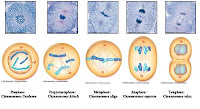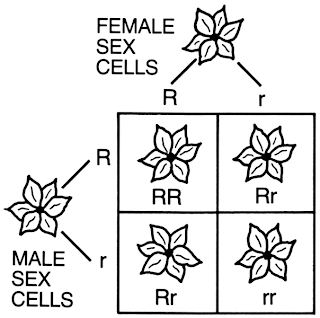- G1- doubles in organelles
- S- DNA replication, duplication of chromosomes
- G2- Growth
2. Cell division
- M- Mitosis
Mitosis is when the parent cell (original) produces daughter cell (duplication)
The process of Mitosis
- Prophase (centrosome duplicates and separates)
- Metaphase (chromosomes are at the center)
- Anaphase (Separate and move to opposite ends)

- Telephase (at opposite ends)
( http://www.biology.iupui.edu/biocourses/N100/2k3ch8mitosisnotes.html)
Meiosis is when the daughter cells divide...so you'll have 4 daughter cells total after the division
- Meiosis I- Line up side by side, paired chromosomes at equator,
- Meiosis II- Zygote (1st new individual)
The stages of Meiosis Prophase I
- Metaphase I
Mitosis vs. Meiosis
- Meiosis requires 2 nuclear divisions, Mitosis only requires 1
- 4 daughter cells for meiosis, mitosis only 2
Spermatogenisis and Oogenisis are the production of sex cells (sperm and egg)
Chapter 21:
The structure of DNA is it "resembles a ladder" (Sylvia Mader, Human Biology 10th Edition). The middle part of the "ladder" is contained of 4 different materials. (A pairs with T: G pairs with C)
When the replication of DNA occurs, only one strand is original. It will duplicate itself to get the other strand.
The structure of RNA differs from DNA because it only has one strand instead of the double helix. Instead of A, T, G, and C...RNA is constructed of A, U, C, and G.
- rRNA joins with proteins and is produced in nucleus
- mRNA is also produced in nucleus and is Messenger RNA
- tRNA must have at least 20 present to keep functioning
Transcription is the process of
- Forming mRNA
- Processing mRNA
- Translation
Chapter 19
According to the Cancer webpage (http://www.cancer.org/) there was an estimated 1,444,920 cases of new cancer in the United States alone. Cancer occurs when a cell does not have the capability of dying(apoptosis). It will just keep regenerating.
Cancers have abnormal nuclei they are larger than others and have a different number of chromosomes.
When cancer cells form they just keep growing until they produce a mass, called a tumor. Cancer cells "pile on top of each other" (Sylvia Mader, Human Biology 10th Edition). Benign tumors are usually contained and are tight together. Cancer usually grows all over the place with no real shape.
Three different stages
- Initiation
- Promotion
- Progression
Cancer can often be a genetic disease. p53 is a protein that stops the cell cycle. A lot of cancers are lacking the p53 protein.
There are different types of cancer
- Prognosis (tumor has spread to tissues and other parts of body)
- Carcinomas (Skin, breast, liver, pancreas, intestines, lung, prostate, thyroid)
- Sarcomas (bone, fibrous)
- Leukemias (blood)
- Lymphomas (lymphatic system)
Cancers, aside from genetics, can also be caused by the environment. Radiation, organic chemicals, and diet can have an effect on cancer.
You have a better chance of going into remission if you follow these 7 steps
- Change in bowel or bladder
- A sore that doesn't heal
- Unusual bleeding
- Thickening or lump

- Indigestion or difficulty swallowing
- Obvious change in move/wart
- Nagging cough or hoarseness
(Page 411 from our Text book, Sylvia Mader Human Biology 10th edition)
There are many different ways to handle cancer and hopefully go into remission
- Surgery
- Radiation
- Chemotherapy
- Bone Marrow transplant
Newer technology
- Immunotherapy
- p53 gene therapy
Genotype are the genes of the individual. Dominant genes are represented with 2 upper case letters(AA), recessive genes are represented with 2 lower case letters(aa), and heterogenius is represented with 1 upper case and 1 lower case(Aa) (although it takes the characteristics of Dominant genes)
The product that we are testing (ex: blond hair) is called the phenotype
When trying to figure out what the percentage of a phenotype you can use the Punnett Square. Here is an example


No comments:
Post a Comment